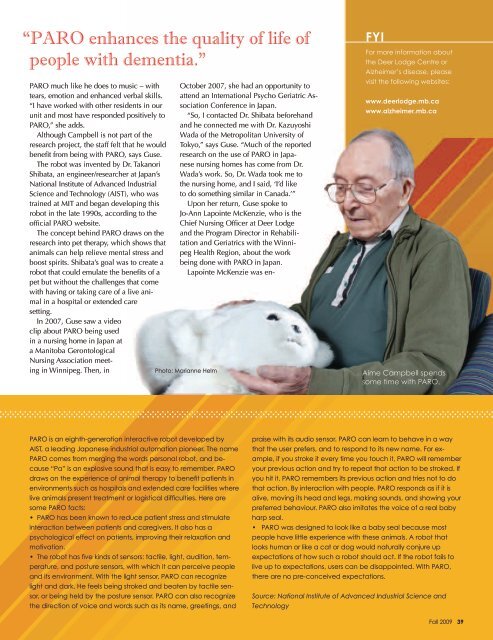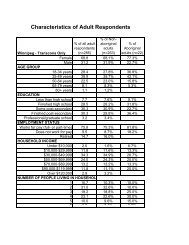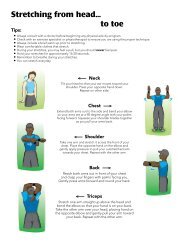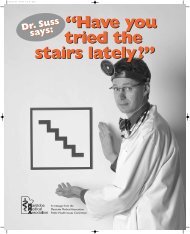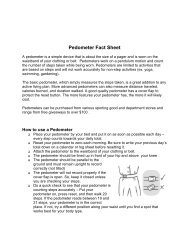Wave: Fall 2009 - Winnipeg Regional Health Authority
Wave: Fall 2009 - Winnipeg Regional Health Authority
Wave: Fall 2009 - Winnipeg Regional Health Authority
- No tags were found...
You also want an ePaper? Increase the reach of your titles
YUMPU automatically turns print PDFs into web optimized ePapers that Google loves.
“PARO enhances the quality of life ofpeople with dementia.”PARO much like he does to music – withtears, emotion and enhanced verbal skills.“I have worked with other residents in ourunit and most have responded positively toPARO,” she adds.Although Campbell is not part of theresearch project, the staff felt that he wouldbenefit from being with PARO, says Guse.The robot was invented by Dr. TakanoriShibata, an engineer/researcher at Japan’sNational Institute of Advanced IndustrialScience and Technology (AIST), who wastrained at MIT and began developing thisrobot in the late 1990s, according to theofficial PARO website.The concept behind PARO draws on theresearch into pet therapy, which shows thatanimals can help relieve mental stress andboost spirits. Shibata’s goal was to create arobot that could emulate the benefits of apet but without the challenges that comewith having or taking care of a live animalin a hospital or extended caresetting.In 2007, Guse saw a videoclip about PARO being usedin a nursing home in Japan ata Manitoba GerontologicalNursing Association meetingin <strong>Winnipeg</strong>. Then, inOctober 2007, she had an opportunity toattend an International Psycho Geriatric AssociationConference in Japan.“So, I contacted Dr. Shibata beforehandand he connected me with Dr. KazuyoshiWada of the Metropolitan University ofTokyo,” says Guse. “Much of the reportedresearch on the use of PARO in Japanesenursing homes has come from Dr.Wada’s work. So, Dr. Wada took me tothe nursing home, and I said, ‘I’d liketo do something similar in Canada.’”Upon her return, Guse spoke toJo-Ann Lapointe McKenzie, who is theChief Nursing Officer at Deer Lodgeand the Program Director in Rehabilitationand Geriatrics with the <strong>Winnipeg</strong><strong>Health</strong> Region, about the workbeing done with PARO in Japan.Lapointe McKenzie was en-Photo: Marianne HelmFYIFor more information aboutthe Deer Lodge Centre orAlzheimer’s disease, pleasevisit the following websites:www.deerlodge.mb.cawww.alzheimer.mb.caAime Campbell spendssome time with PARO.PARO is an eighth-generation interactive robot developed byAIST, a leading Japanese industrial automation pioneer. The namePARO comes from merging the words personal robot, and because“Pa” is an explosive sound that is easy to remember. PAROdraws on the experience of animal therapy to benefit patients inenvironments such as hospitals and extended care facilities wherelive animals present treatment or logistical difficulties. Here aresome PARO facts:• PARO has been known to reduce patient stress and stimulateinteraction between patients and caregivers. It also has apsychological effect on patients, improving their relaxation andmotivation.• The robot has five kinds of sensors: tactile, light, audition, temperature,and posture sensors, with which it can perceive peopleand its environment. With the light sensor, PARO can recognizelight and dark. He feels being stroked and beaten by tactile sensor,or being held by the posture sensor. PARO can also recognizethe direction of voice and words such as its name, greetings, andpraise with its audio sensor. PARO can learn to behave in a waythat the user prefers, and to respond to its new name. For example,if you stroke it every time you touch it, PARO will rememberyour previous action and try to repeat that action to be stroked. Ifyou hit it, PARO remembers its previous action and tries not to dothat action. By interaction with people, PARO responds as if it isalive, moving its head and legs, making sounds, and showing yourpreferred behaviour. PARO also imitates the voice of a real babyharp seal.• PARO was designed to look like a baby seal because mostpeople have little experience with these animals. A robot thatlooks human or like a cat or dog would naturally conjure upexpectations of how such a robot should act. If the robot fails tolive up to expectations, users can be disappointed. With PARO,there are no pre-conceived expectations.Source: National Institute of Advanced Industrial Science andTechnology<strong>Fall</strong> <strong>2009</strong> 39


